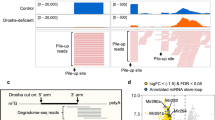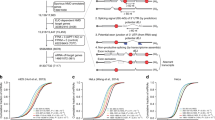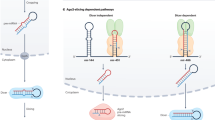Abstract
During microRNA (miRNA) biogenesis, one strand of a ∼21–22-nucleotide RNA duplex is preferentially selected for entry into a silencing complex. The other strand, known as the miRNA* species, has typically been assumed to be a carrier strand. Here we show that, although Drosophila melanogaster miRNA* species are less abundant than their partners, they are often present at physiologically relevant levels and can associate with Argonaute proteins. Comparative genomic analyses revealed that >40% of miRNA* sequences resist nucleotide divergence across Drosophilid evolution, and at least half of these well-conserved miRNA* species select for conserved 3′ untranslated region seed matches well above background noise. Finally, we validated the inhibitory activity of miRNA* species in both cultured cells and transgenic animals. These data broaden the reach of the miRNA regulatory network and suggest an important mechanism that diversifies miRNA function during evolution.
This is a preview of subscription content, access via your institution
Access options
Subscribe to this journal
Receive 12 print issues and online access
$189.00 per year
only $15.75 per issue
Buy this article
- Purchase on Springer Link
- Instant access to full article PDF
Prices may be subject to local taxes which are calculated during checkout







Similar content being viewed by others
References
Lai, E.C. MicroRNAs: runts of the genome assert themselves. Curr. Biol. 13, R925–R936 (2003).
Bushati, N. & Cohen, S.M. MicroRNA functions. Annu. Rev. Cell Dev. Biol. 23, 175–205 (2007).
Lee, Y. et al. The nuclear RNase III Drosha initiates microRNA processing. Nature 425, 415–419 (2003).
Okamura, K., Hagen, J.W., Duan, H., Tyler, D.M. & Lai, E.C. The mirtron pathway generates microRNA-class regulatory RNAs in Drosophila. Cell 130, 89–100 (2007).
Ruby, J.G., Jan, C.H. & Bartel, D.P. Intronic microRNA precursors that bypass Drosha processing. Nature 448, 83–86 (2007).
Berezikov, E., Chung, W.-J., Willis, J., Cuppen, E. & Lai, E.C. Mammalian mirtron genes. Mol. Cell 28, 328–336 (2007).
Hutvagner, G. et al. A cellular function for the RNA-interference enzyme Dicer in the maturation of the let-7 small temporal RNA. Science 293, 834–838 (2001).
Grishok, A. et al. Genes and mechanisms related to RNA interference regulate expression of the small temporal RNAs that control C. elegans developmental timing. Cell 106, 23–34 (2001).
Ketting, R.F. et al. Dicer functions in RNA interference and in synthesis of small RNAs involved in developmental timing in C. elegans. Genes Dev. 15, 2654–2659 (2001).
Knight, S.W. & Bass, B.L. A role for the RNase III enzyme DCR-1 in RNA interference and germ line development in Caenorhabditis elegans. Science 293, 2269–2271 (2001).
Lau, N.C., Lim, L., Weinstein, E. & Bartel, D.P. An abundant class of tiny RNAs with probable regulatory roles in Caenorhabditis elegans. Science 294, 858–862 (2001).
Lai, E.C., Tam, B. & Rubin, G.M. Pervasive regulation of Drosophila Notch target genes by GY-box-, Brd-box-, and K-box-class microRNAs. Genes Dev. 19, 1067–1080 (2005).
Lai, E.C. MicroRNAs are complementary to 3′ UTR sequence motifs that mediate negative post-transcriptional regulation. Nat. Genet. 30, 363–364 (2002).
Brennecke, J., Stark, A., Russell, R.B. & Cohen, S.M. Principles of microRNA-target recognition. PLoS Biol. 3, e85 (2005).
Doench, J.G. & Sharp, P.A. Specificity of microRNA target selection in translational repression. Genes Dev. 18, 504–511 (2004).
Lewis, B.P., Shih, I.H., Jones-Rhoades, M.W., Bartel, D.P. & Burge, C.B. Prediction of mammalian microRNA targets. Cell 115, 787–798 (2003).
Stark, A., Brennecke, J., Bushati, N., Russell, R.B. & Cohen, S.M. Animal microRNAs confer robustness to gene expression and have a significant impact on 3′UTR evolution. Cell 123, 1133–1146 (2005).
Grun, D., Wang, Y.L., Langenberger, D., Gunsalus, K.C. & Rajewsky, N. MicroRNA target predictions across seven Drosophila species and comparison to mammalian targets. PLoS Comp. Biol. 1, e13 (2005).
Farh, K.K. et al. The widespread impact of mammalian microRNAs on mRNA repression and evolution. Science 310, 1817–1821 (2005).
Lai, E.C. Predicting and validating microRNA targets. Genome Biol. 5, 115 (2004).
Khvorova, A., Reynolds, A. & Jayasena, S.D. Functional siRNAs and miRNAs exhibit strand bias. Cell 115, 209–216 (2003).
Schwarz, D.S. et al. Asymmetry in the assembly of the RNAi enzyme complex. Cell 115, 199–208 (2003).
Kloosterman, W.P. et al. Cloning and expression of new microRNAs from zebrafish. Nucleic Acids Res. 34, 2558–2569 (2006).
Ruby, J.G. et al. Large-scale sequencing reveals 21U-RNAs and additional microRNAs and endogenous siRNAs in C. elegans. Cell 127, 1193–1207 (2006).
Ruby, J.G. et al. Evolution, biogenesis, expression, and target predictions of a substantially expanded set of Drosophila microRNAs. Genome Res. 17, 1850–1864 (2007).
Aravin, A.A. et al. The small RNA profile during Drosophila melanogaster development. Dev. Cell 5, 337–350 (2003).
Forstemann, K., Horwich, M.D., Wee, L., Tomari, Y. & Zamore, P.D. Drosophila microRNAs are sorted into functionally distinct Argonaute complexes after production by Dicer-1. Cell 130, 287–297 (2007).
Tomari, Y., Du, T. & Zamore, P.D. Sorting of Drosophila small silencing RNAs. Cell 130, 299–308 (2007).
Silver, S.J., Hagen, J.W., Okamura, K., Perrimon, N. & Lai, E.C. Functional screening identifies miR-315 as a potent activator of Wingless signaling. Proc. Natl. Acad. Sci. USA 104, 18151–18156 (2007).
Ronshaugen, M., Biemar, F., Piel, J., Levine, M. & Lai, E.C. The Drosophila microRNA iab-4 causes a dominant homeotic transformation of halteres to wings. Genes Dev. 19, 2947–2952 (2005).
Bender, W. MicroRNAs in the Drosophila bithorax complex. Genes Dev. 22, 14–19 (2008).
Stark, A. et al. A single Hox locus in Drosophila produces functional microRNAs from opposite DNA strands. Genes Dev. 22, 8–13 (2008).
Tyler, D.M. et al. Functionally distinct regulatory RNAs generated by bidirectional transcription and processing of microRNA loci. Genes Dev. 22, 26–36 (2008).
Stark, A., Brennecke, J., Russell, R.B. & Cohen, S.M. Identification of Drosophila microRNA targets. PLoS Biol. 1, e60 (2003).
Jackson, A.L. et al. Expression profiling reveals off-target gene regulation by RNAi. Nat. Biotechnol. 21, 635–637 (2003).
Lai, E.C., Tomancak, P., Williams, R.W. & Rubin, G.M. Computational identification of Drosophila microRNA genes. Genome Biol. 4, R42 (2003).
Berezikov, E. et al. Phylogenetic shadowing and computational identification of human microRNA genes. Cell 120, 21–24 (2005).
Gu, J., Fu, H., Zhang, X. & Li, Y. Identifications of conserved 7-mers in 3-UTRs and microRNAs in Drosophila. BMC Bioinformatics 8, 432 (2007).
Hutvagner, G., Simard, M.J., Mello, C.C. & Zamore, P.D. Sequence-specific inhibition of small RNA function. PLoS Biol. 2, e98 (2004).
Meister, G., Landthaler, M., Dorsett, Y. & Tuschl, T. Sequence-specific inhibition of microRNA- and siRNA-induced RNA silencing. RNA 10, 544–550 (2004).
Grimson, A. et al. MicroRNA targeting specificity in mammals: determinants beyond seed pairing. Mol. Cell 27, 91–105 (2007).
Nielsen, C.B. et al. Determinants of targeting by endogenous and exogenous microRNAs and siRNAs. RNA 13, 1894–1910 (2007).
Lewis, B.P., Burge, C.B. & Bartel, D.P. Conserved seed pairing, often flanked by adenosines, indicates that thousands of human genes are microRNA targets. Cell 120, 15–20 (2005).
Gaidatzis, D., van Nimwegen, E., Hausser, J. & Zavolan, M. Inference of miRNA targets using evolutionary conservation and pathway analysis. BMC Bioinformatics 8, 69 (2007).
Majoros, W.H. & Ohler, U. Spatial preferences of microRNA targets in 3′ untranslated regions. BMC Genomics 8, 152 (2007).
Cook, O., Biehs, B. & Bier, E. brinker and optomotor-blind act coordinately to initiate development of the L5 wing vein primordium in Drosophila. Development 131, 2113–2124 (2004).
Stark, A. et al. Discovery of functional elements in 12 Drosophila genomes using evolutionary signatures. Nature 450, 219–232 (2007).
Stark, A. et al. Systematic discovery and characterization of fly microRNAs using 12 Drosophila genomes. Genome Res. 17, 1865–1879 (2007).
Lai, E.C., Wiel, C. & Rubin, G.M. Complementary miRNA pairs suggest a regulatory role for miRNA:miRNA duplexes. RNA 10, 171–175 (2004).
Lai, E.C. & Rubin, G.M. neuralized functions cell-autonomously to regulate a subset of Notch-dependent processes during adult Drosophila development. Dev. Biol. 231, 217–233 (2001).
Hu, S., Fambrough, D., Atashi, J.R., Goodman, C.S. & Crews, S.T. The Drosophila abrupt gene encodes a BTB-zinc finger regulatory protein that controls the specificity of neuromuscular connections. Genes Dev. 9, 2936–2948 (1995).
Acknowledgements
We thank B. Tam (University of California, Davis) for helping to construct transgenic sensors. We thank J.G. Ruby and D. Bartel (Howard Hughes Medical Institute and Whitehead Institute) for sharing their initial analysis of Drosophila miRNAs; S. Crews (University of North Carolina) for the Abrupt antibody; the University of California, Santa Cruz genome center, Agencourt, and the Baylor College of Medicine for Drosophila genome sequences, assemblies and alignments; and J. Major (Sloan-Kettering Institute) for software and technical support. K.O. was supported by a grant from the Charles Revson Foundation. E.C.L. was supported by grants from the Leukemia and Lymphoma Society, the Burroughs Wellcome Foundation, the V Foundation for Cancer Research, the Sidney Kimmel Cancer Foundation and the US National Institutes of Health (GM083300).
Author information
Authors and Affiliations
Contributions
K.O. performed the northern blots, IP tests and luciferase sensor assays; M.D.P. performed the computational analysis; D.M.T. performed imaginal disc stainings; H.D. and Y.-t.C. prepared sensor constructs; E.C.L. wrote the manuscript.
Corresponding author
Supplementary information
Supplementary Text and Figures
Supplementary Figures 1–4 and Supplementary Methods (PDF 7803 kb)
Supplementary Table 1
miRNA/miRNA* clone counts and ratios across Drosophila development. (XLS 125 kb)
Supplementary Table 2
Segregated clone data of 26 genes that generated at least 50 reads in all 4 embryonic time windows. (XLS 38 kb)
Supplementary Table 3
Target signal noise and P-values for the 65 highly conserved (HC) miRNA and miRNA* seeds. (XLS 24 kb)
Supplementary Table 4
Target signal noise and P-values for the 20 poorly conserved (PC) miRNA and miRNA* seeds. (XLS 19 kb)
Rights and permissions
About this article
Cite this article
Okamura, K., Phillips, M., Tyler, D. et al. The regulatory activity of microRNA* species has substantial influence on microRNA and 3′ UTR evolution. Nat Struct Mol Biol 15, 354–363 (2008). https://doi.org/10.1038/nsmb.1409
Received:
Accepted:
Published:
Issue Date:
DOI: https://doi.org/10.1038/nsmb.1409
This article is cited by
-
A comprehensive pan-cancer analysis reveals cancer-associated robust isomiR expression landscapes in miRNA arm switching
Molecular Genetics and Genomics (2023)
-
miR-6893-3p is a bonafide negative regulator of splicing activator, RNPS1
3 Biotech (2023)
-
One locus, several functional RNAs—emerging roles of the mechanisms responsible for the sequence variability of microRNAs
Biologia Futura (2023)
-
MicroRNA: noncoding but still coding, another example of self-catalysis
Functional & Integrative Genomics (2023)
-
MiRNA fine tuning for crop improvement: using advance computational models and biotechnological tools
Molecular Biology Reports (2022)



